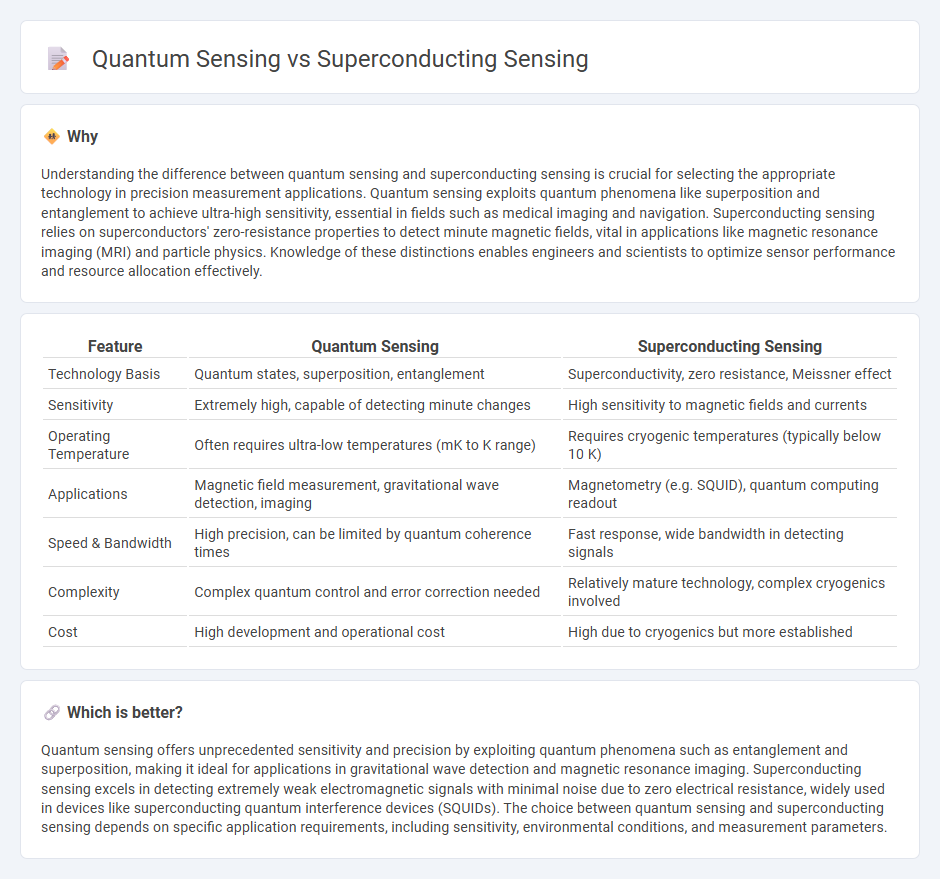
Quantum sensing leverages quantum entanglement and superposition to achieve ultra-sensitive measurements beyond classical limits, enabling breakthroughs in magnetic field detection and timekeeping. Superconducting sensing utilizes superconductors' zero resistance and magnetic flux quantization to detect minute electromagnetic variations with exceptional precision. Explore how these cutting-edge technologies are reshaping the future of sensing applications.
Why it is important
Understanding the difference between quantum sensing and superconducting sensing is crucial for selecting the appropriate technology in precision measurement applications. Quantum sensing exploits quantum phenomena like superposition and entanglement to achieve ultra-high sensitivity, essential in fields such as medical imaging and navigation. Superconducting sensing relies on superconductors' zero-resistance properties to detect minute magnetic fields, vital in applications like magnetic resonance imaging (MRI) and particle physics. Knowledge of these distinctions enables engineers and scientists to optimize sensor performance and resource allocation effectively.
Comparison Table
| Feature | Quantum Sensing | Superconducting Sensing |
|---|---|---|
| Technology Basis | Quantum states, superposition, entanglement | Superconductivity, zero resistance, Meissner effect |
| Sensitivity | Extremely high, capable of detecting minute changes | High sensitivity to magnetic fields and currents |
| Operating Temperature | Often requires ultra-low temperatures (mK to K range) | Requires cryogenic temperatures (typically below 10 K) |
| Applications | Magnetic field measurement, gravitational wave detection, imaging | Magnetometry (e.g. SQUID), quantum computing readout |
| Speed & Bandwidth | High precision, can be limited by quantum coherence times | Fast response, wide bandwidth in detecting signals |
| Complexity | Complex quantum control and error correction needed | Relatively mature technology, complex cryogenics involved |
| Cost | High development and operational cost | High due to cryogenics but more established |
Which is better?
Quantum sensing offers unprecedented sensitivity and precision by exploiting quantum phenomena such as entanglement and superposition, making it ideal for applications in gravitational wave detection and magnetic resonance imaging. Superconducting sensing excels in detecting extremely weak electromagnetic signals with minimal noise due to zero electrical resistance, widely used in devices like superconducting quantum interference devices (SQUIDs). The choice between quantum sensing and superconducting sensing depends on specific application requirements, including sensitivity, environmental conditions, and measurement parameters.
Connection
Quantum sensing and superconducting sensing are interconnected through their reliance on quantum phenomena to achieve extreme sensitivity and precision. Superconducting sensors utilize quantum states like the Josephson effect and flux quantization to detect minute changes in magnetic fields, temperature, and electromagnetic radiation. This integration of superconducting materials with quantum sensing techniques enables breakthroughs in medical imaging, navigation, and fundamental physics research.
Key Terms
Zero Electrical Resistance (Superconducting Sensing)
Superconducting sensing leverages zero electrical resistance to achieve ultra-sensitive detection by minimizing energy loss and noise in measurement circuits. Quantum sensing exploits quantum phenomena like superposition and entanglement to enhance precision beyond classical limits, often employing superconducting materials for optimized performance. Explore the distinct mechanisms and applications of superconducting versus quantum sensing technologies to understand their cutting-edge advancements.
Quantum Entanglement (Quantum Sensing)
Quantum sensing harnesses quantum entanglement to achieve unparalleled sensitivity and precision beyond classical limits, utilizing entangled particles to measure physical quantities such as magnetic fields and temperature with exceptional accuracy. Superconducting sensing relies on superconducting materials and devices, like SQUIDs, to detect minute magnetic signals but does not exploit quantum entanglement for enhanced measurement capabilities. Explore how quantum entanglement revolutionizes sensing technologies by enabling breakthroughs in detection performance and applications.
Measurement Sensitivity
Superconducting sensing leverages zero electrical resistance and strong magnetic field detection to achieve ultra-high measurement sensitivity, ideal for detecting minute magnetic flux changes in applications like SQUID magnetometers. Quantum sensing exploits quantum phenomena such as entanglement and superposition to surpass classical limits, enabling enhanced precision in measuring time, magnetic fields, and gravitational forces. Explore the latest advancements to understand the comparative advantages of superconducting and quantum sensing technologies in ultra-sensitive measurements.
Source and External Links
Scientists Amplify Superconducting Sensor Arrays Signals Near the Quantum Limit - Superconducting sensors, such as those used for X-ray detection, combine superconducting thermometers and absorbers into arrays, amplified by specialized electronics including microwave multiplexers and ultra-low-noise amplifiers to achieve high sensitivity at extremely low temperatures.
Revolutionary Superconducting Transition-Edge Sensors Achieve Unprecedented Photon Sensitivity at Nanoscale - FeSeTe-based superconducting sensors achieve nanoscale resolution and exceptional photon sensitivity, mapping photoinduced changes with high spatial accuracy and enabling real-time monitoring of ultrafast quantum processes.
SQUID - Wikipedia - SQUID magnetometers are highly sensitive devices, capable of detecting extremely weak magnetic fields--down to a few femtotesla--by utilizing superconducting loops with Josephson junctions.
 dowidth.com
dowidth.com